Minerals Technologies Bundle
How Does Minerals Technologies Thrive in the Industrial World?
Minerals Technologies Inc. (MTI) is a global leader in specialty minerals and materials, constantly evolving through strategic product development and market expansion. MTI supplies essential mineral-based and synthetic mineral products, alongside related systems and services, to a diverse array of industries. Understanding the Minerals Technologies SWOT Analysis is key to grasping its position.
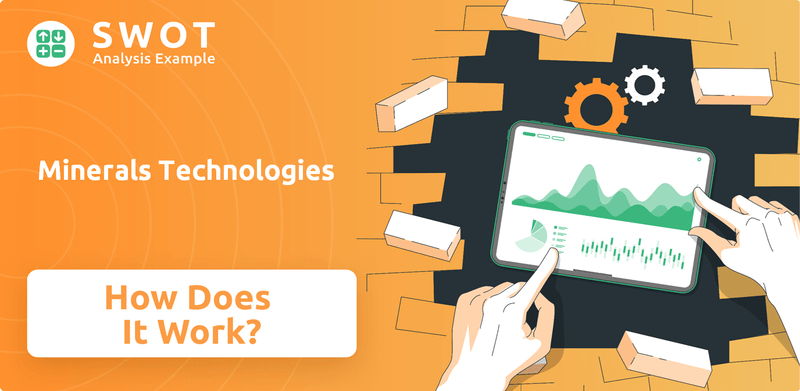
This exploration will uncover how the MTI company operates within the mining industry, examining its role in mineral processing and its impact across various sectors. We'll dissect its business model, revenue streams, and strategic initiatives to understand how Minerals Technologies maintains its competitive edge. This analysis is crucial for investors, industry observers, and anyone interested in the dynamics of industrial minerals and the specialty minerals market.
What Are the Key Operations Driving Minerals Technologies’s Success?
Minerals Technologies Inc. (MTI) creates value through its three main segments: Specialty Minerals, Performance Materials, and Refractories. Each segment provides specialized products and services to different customer groups. For example, the Specialty Minerals segment supplies precipitated calcium carbonate (PCC) to the paper industry, improving paper quality.
The company's operations involve extensive mining, mineral processing, and manufacturing. MTI's global supply chain is a key advantage, allowing for efficient delivery worldwide. They use proprietary technologies to tailor solutions to specific customer needs, often collaborating closely with clients to optimize product performance and cost-effectiveness. This approach helps differentiate MTI in the market.
MTI's business model focuses on providing customized solutions and building strong customer relationships. This strategy results in improved product quality, lower operational costs, and enhanced environmental performance for its customers. MTI's commitment to innovation and customer service is central to its value proposition.
Supplies PCC and other mineral-based solutions to industries like paper, building materials, and food. Key products enhance paper brightness and printability. This segment is a major player in the Target Market of Minerals Technologies.
Focuses on bentonite and other mineral-based products. These products are used in foundry, drilling, and environmental applications. They provide solutions for metal casting, well construction, and waste containment.
Provides monolithic refractories, precast shapes, and refractory services. These are essential for lining high-temperature furnaces in industries like steel. The segment ensures efficient production in industrial markets.
Involve mining, mineral processing, and manufacturing. MTI uses advanced technologies and a global supply chain. They often operate satellite PCC plants directly at paper mills for logistical advantages.
MTI's success is built on its ability to offer customized solutions and build strong customer relationships. This approach provides significant benefits to its clients. The company's focus on innovation and customer service sets it apart in the industrial minerals sector.
- Global supply chain for efficient delivery.
- Proprietary technologies and application expertise.
- On-site production models, like satellite PCC plants.
- Close collaboration with clients to optimize performance.
Minerals Technologies SWOT Analysis
- Complete SWOT Breakdown
- Fully Customizable
- Editable in Excel & Word
- Professional Formatting
- Investor-Ready Format
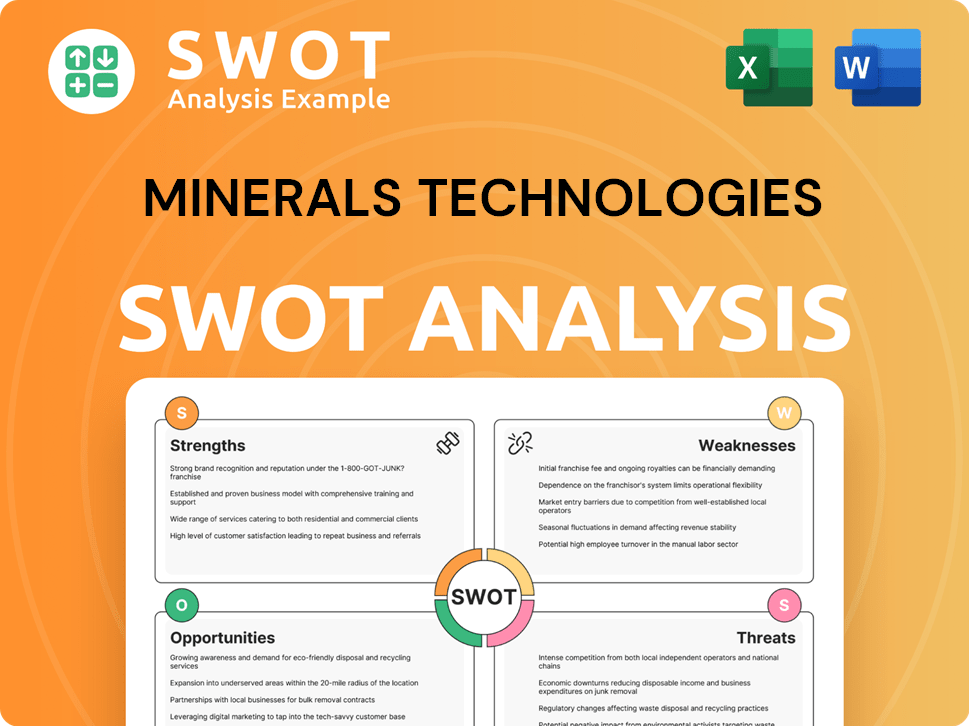
How Does Minerals Technologies Make Money?
The core of Minerals Technologies' business revolves around generating revenue through the sale of its diverse range of mineral-based products and related services. This includes specialty minerals, mineral-based products, and synthetic mineral offerings. The company's revenue streams are primarily segmented across its three operational divisions, ensuring a diversified approach to market engagement.
In 2023, the company reported net sales of approximately $2.23 billion, showcasing the substantial scale of its operations. While specific detailed breakdowns for 2024 and 2025 are not yet fully available in public reports, historical trends indicate that product sales consistently form the majority of its revenue. This underscores the importance of its product portfolio in driving financial performance.
The company's revenue model is built on a foundation of product sales, with a significant portion derived from long-term supply agreements, particularly in its PCC operations. Value-based pricing strategies are also employed, capitalizing on the technological leadership and performance advantages of its products.
The company's monetization strategies are multifaceted, focusing on both product sales and service provision. The Specialty Minerals segment contributes significantly through products like precipitated calcium carbonate (PCC), processed minerals, and lime. The Performance Materials segment generates revenue from bentonite-based products for various industrial applications. The Refractories segment monetizes its offerings through the sale of monolithic refractories, precast shapes, and refractory services.
- Product Sales: The primary revenue source, encompassing a wide array of specialty and industrial minerals.
- Long-Term Supply Agreements: Especially crucial for PCC operations, securing a stable revenue base.
- Value-Based Pricing: Leveraging technological superiority and performance benefits to justify pricing.
- Integrated Solutions: Offering a combination of products and related services to maximize customer value.
Minerals Technologies PESTLE Analysis
- Covers All 6 PESTLE Categories
- No Research Needed – Save Hours of Work
- Built by Experts, Trusted by Consultants
- Instant Download, Ready to Use
- 100% Editable, Fully Customizable
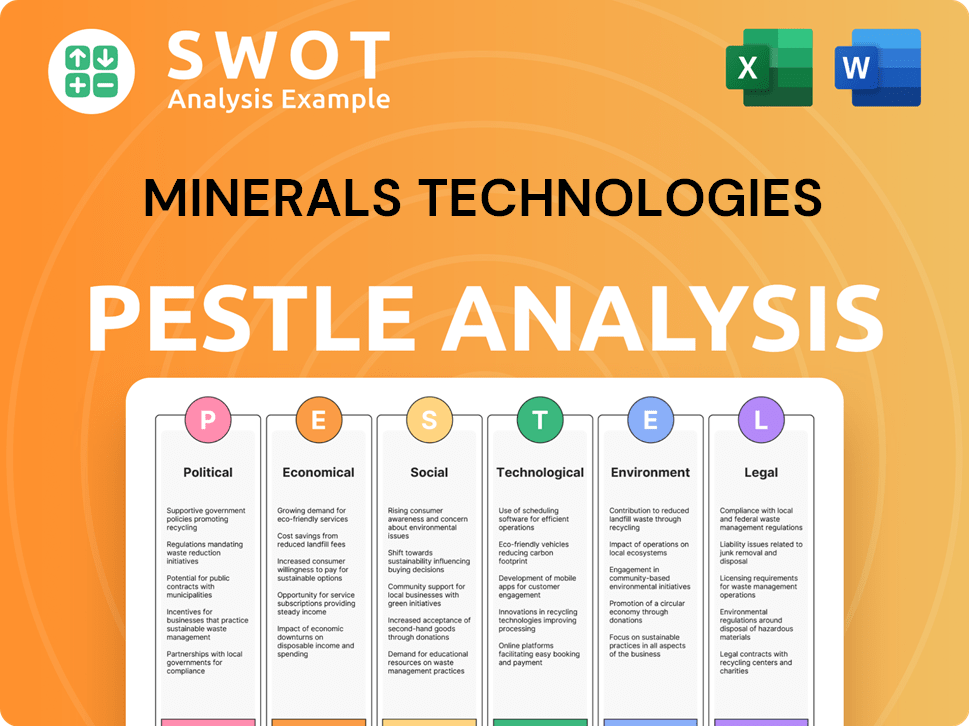
Which Strategic Decisions Have Shaped Minerals Technologies’s Business Model?
The strategic evolution of Minerals Technologies Inc. (MTI) showcases a commitment to innovation and operational excellence. Key milestones include the expansion of its precipitated calcium carbonate (PCC) business, particularly through the establishment of satellite plants at customer locations. This approach has been a foundational element of its competitive strategy, ensuring strong customer relationships and efficient logistics.
Strategic moves by MTI have consistently focused on strengthening its technological leadership and market position. Continuous investments in research and development, especially in advanced mineral processing and synthetic mineral development, are a core component of its strategy. These investments enable the company to introduce new product formulations and enhance the sustainability of its offerings.
MTI's competitive edge is built on a combination of factors, including brand strength, technology leadership, and economies of scale. The company's global presence and diversified sourcing strategies allow it to manage operational challenges effectively. MTI adapts to market trends by innovating its product portfolio and operational practices.
MTI's history is marked by significant achievements, including the expansion of its PCC business. The establishment of satellite plants at customer paper mills has been a key strategic move. These plants have improved logistics and strengthened customer relationships.
Ongoing investment in research and development is a strategic priority for MTI. The company regularly introduces new product formulations to meet evolving industry demands. MTI focuses on improving the sustainability of its products and operations.
MTI's competitive advantages include brand strength and technology leadership. Economies of scale and a global network of operations enhance its position. MTI's ability to adapt to new trends, such as the demand for sustainable materials, is crucial.
In recent years, MTI has demonstrated resilience in the face of economic challenges. The company's financial performance reflects its strategic initiatives and operational efficiency. For detailed insights, explore the Brief History of Minerals Technologies.
MTI's competitive advantages are multifaceted, including brand strength, technology leadership, and economies of scale. MTI's global network and customer proximity further enhance its competitive edge. The company's ability to adapt to new trends ensures its continued relevance in the market.
- Strong brand reputation built on decades of reliable performance.
- Technological leadership in PCC and specialized bentonite applications.
- Economies of scale in large-volume mineral processing operations.
- Extensive global network of operations and technical service centers.
Minerals Technologies Business Model Canvas
- Complete 9-Block Business Model Canvas
- Effortlessly Communicate Your Business Strategy
- Investor-Ready BMC Format
- 100% Editable and Customizable
- Clear and Structured Layout
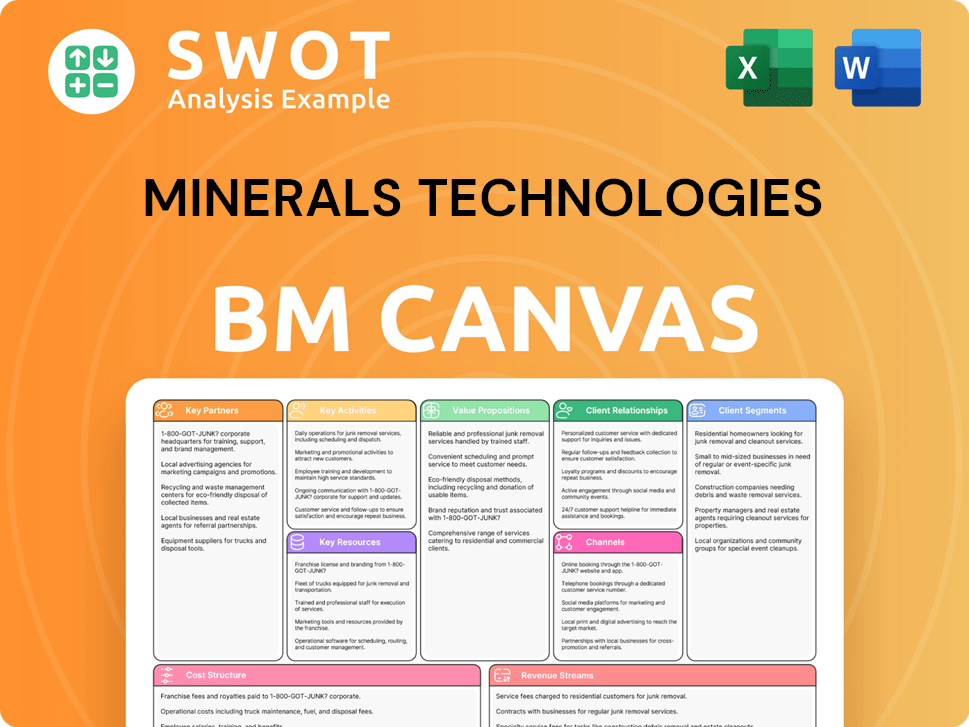
How Is Minerals Technologies Positioning Itself for Continued Success?
The MTI company holds a strong position in the industrial minerals market. It is a leading global supplier, particularly in precipitated calcium carbonate (PCC) for the paper industry. The company's success is built on its proprietary technology, on-site plant model, and strong customer relationships.
The company's global reach extends across North America, South America, Europe, and Asia, ensuring a diversified customer base. Its focus on innovation, market expansion, and sustainability is key for long-term growth.
The MTI company has a substantial market share in its core segments. It is a major player in bentonite-based products and refractory materials. Customer loyalty is high due to the critical nature of its products.
Key risks include fluctuations in raw material costs and economic downturns in key sectors. Regulatory changes and new competitors pose potential challenges. The company actively mitigates these risks through strategic initiatives.
The company focuses on innovation, operational excellence, and strategic acquisitions. Leadership emphasizes continued market expansion and sustainability. The company aims to generate revenue and profit long term.
Ongoing investments in research and development create new products. The company focuses on operational efficiency to reduce costs. Strategic acquisitions are used to expand the product portfolio and geographic reach.
The MTI company's financial results reflect its market position and the dynamics of the industrial minerals sector. The company's performance is closely tied to the paper, steel, and construction industries. Recent data indicates that the company is navigating challenges related to raw material costs and market demand.
- The company's financial performance is influenced by global economic conditions.
- The demand for specialty minerals is driven by industrial production and infrastructure projects.
- Sustainability practices and environmental regulations are increasingly important.
- For more insights, consider reading about the Owners & Shareholders of Minerals Technologies.
Minerals Technologies Porter's Five Forces Analysis
- Covers All 5 Competitive Forces in Detail
- Structured for Consultants, Students, and Founders
- 100% Editable in Microsoft Word & Excel
- Instant Digital Download – Use Immediately
- Compatible with Mac & PC – Fully Unlocked
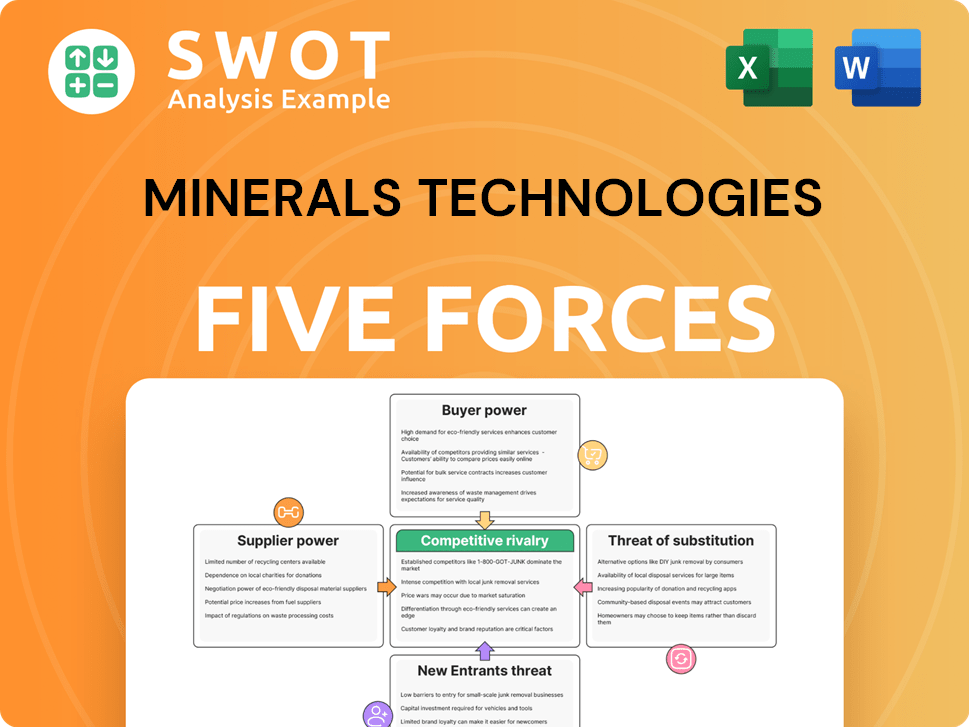
Related Blogs
- What are Mission Vision & Core Values of Minerals Technologies Company?
- What is Competitive Landscape of Minerals Technologies Company?
- What is Growth Strategy and Future Prospects of Minerals Technologies Company?
- What is Sales and Marketing Strategy of Minerals Technologies Company?
- What is Brief History of Minerals Technologies Company?
- Who Owns Minerals Technologies Company?
- What is Customer Demographics and Target Market of Minerals Technologies Company?
Disclaimer
All information, articles, and product details provided on this website are for general informational and educational purposes only. We do not claim any ownership over, nor do we intend to infringe upon, any trademarks, copyrights, logos, brand names, or other intellectual property mentioned or depicted on this site. Such intellectual property remains the property of its respective owners, and any references here are made solely for identification or informational purposes, without implying any affiliation, endorsement, or partnership.
We make no representations or warranties, express or implied, regarding the accuracy, completeness, or suitability of any content or products presented. Nothing on this website should be construed as legal, tax, investment, financial, medical, or other professional advice. In addition, no part of this site—including articles or product references—constitutes a solicitation, recommendation, endorsement, advertisement, or offer to buy or sell any securities, franchises, or other financial instruments, particularly in jurisdictions where such activity would be unlawful.
All content is of a general nature and may not address the specific circumstances of any individual or entity. It is not a substitute for professional advice or services. Any actions you take based on the information provided here are strictly at your own risk. You accept full responsibility for any decisions or outcomes arising from your use of this website and agree to release us from any liability in connection with your use of, or reliance upon, the content or products found herein.